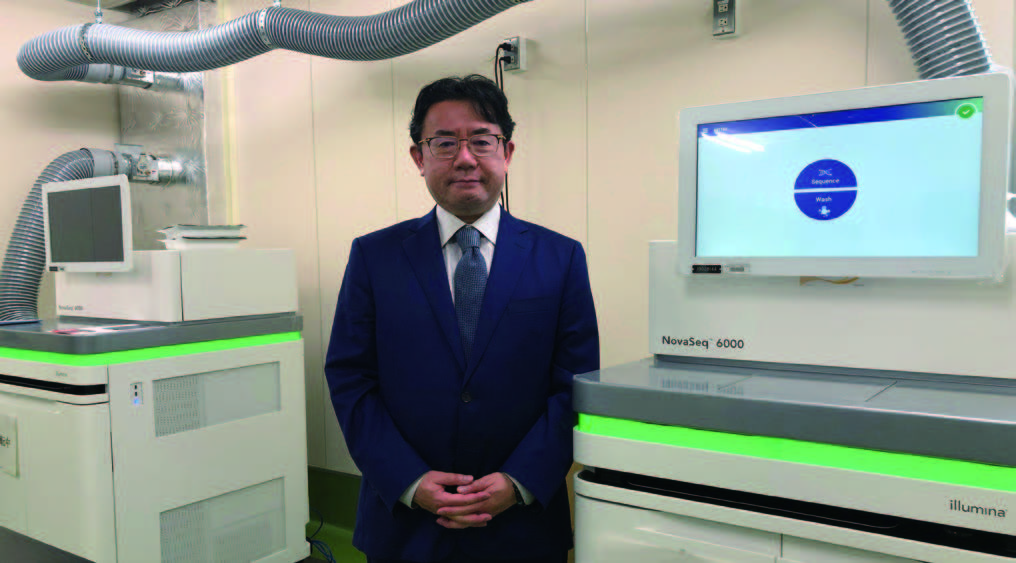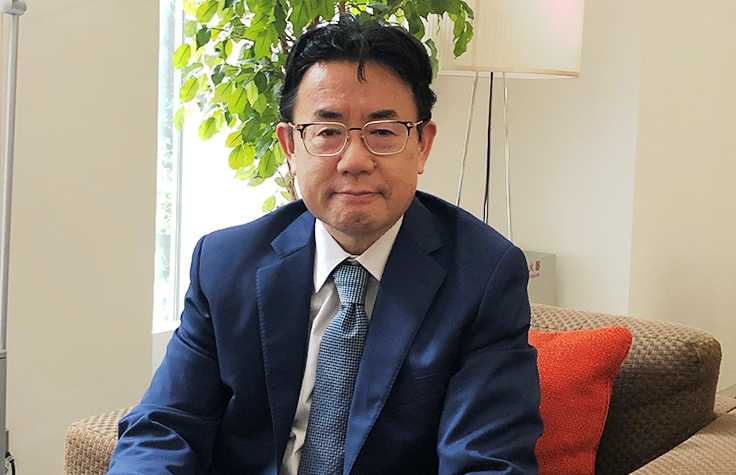Case Study: Eisai Co., Ltd
Introduction
Eisai introduced two Illumina high-throughput NGS systems, NovaSeq 6000 Systems, in Tsukuba Research Laboratories in 2020 in order for next-generation drug discovery and drug development research in oncology.
Dr. Yasuhiro Funabashi, Deputy Chief Scientific Officer, Oncology Business Group, Eisai Co., Ltd discussed their reasons for introducing these systems and their plans for utilizing them.

Dr. Yasuhiro Funabashi (PhD, Pharmaceutical Sciences) is the Deputy Chief Scientific Officer, Oncology Business Group of Eisai Co., Ltd in Japan.
Advantages and challenges of introducing multiple NovaSeq 6000 Systems
With the advancement of NGS analysis technologies, there has been a shift towards precision medicine, and targeted therapies have led to improved patient treatment and outcomes in many cancers. In addition, the success of immune checkpoint inhibitors, which act on immune cells to exert an antitumor effect, have demonstrated the importance of developing drugs that have an effect on the tumor microenvironment (TME) for anticancer drug discovery and drug development research.
The identification of new cancer driver mutations is important. However, we believe that the future of precision medicine will move toward developing drugs with new target signals or target molecules in the TME that will be revealed by elucidating genomic changes such as microsatellite instability (MSI) and tumor mutation burden (TMB), and by examining the cancer itself and also cancer evolution using tools such as whole genome analysis and epigenome analysis. We believe that integrating NGS data e.g. genomic structural abnormalities with clinical research information will greatly aid our drug development efforts.
In the past, we have leveraged the NextSeq system for exome sequencing and RNA-Seq for exploratory research. We have now decided to introduce two NovaSeq 6000 Systems because the idea of performing NGS analysis of clinical samples for in-house research to acquire data in real-time, and drug discovery focused on genomic changes and the TME has gained much traction among our in-house development researchers. We also hope this move will be well-received by academic researchers in Japan. Previously, we had outsourced most of our large-scale NGS analysis overseas, particularly for clinical biomarker studies. We hope that it will now be easier to collaborate with academic organizations on projects around genomic analysis and TME research, and Eisai will be able to serve as a research hub by enabling in-house NGS analysis of clinical samples in Japan. In fact, we have already received positive feedback from academic researchers who are keen to collaborate after finding out that Eisai is conducting NGS analysis in Japan.
One of the challenges is lab quality control. Until now, we have used in-house NGS analysis mainly for exploratory research purposes. However, in the future, we will need to establish GLP equivalent standards for sequencing, manage samples, and improve our analysis pipeline for NGS data. Also, there is the challenge of establishing a platform for integrated analysis of clinical research information and genomic information. We are in the process of hiring bioinformaticians, but we are keenly aware of the talent shortage, especially in the field of NGS research such as whole genome analysis, and fierce competition in Japan for hiring such talent.
Liquid biopsy strategy in Eisai
More than 10 years ago, I became interested in LB because of BEAMing technology. In 2012, in a lecture by Professor Bert Vogelstein at Johns Hopkins University, who is known for his research on tumor suppressor gene mutations and carcinogenesis of colorectal cancer, I was struck by his observation that although research in LB had progressed in advanced cancer, LB had the potential to be effective in detecting early-stage cancer if the problem of detection sensitivity was overcome. As a result, I became very interested in LB research that led to the development of therapeutic agents for early-stage cancer. Since 2012, Eisai has been conducting retrospective LB analysis in our drug development research, and we have been collecting blood samples from all stages, ranging from baseline to disease progression in clinical studies. With the advancement of technology that now allows us to analyze LB using NGS and the introduction of NovaSeq 6000 System in our labs, we will finally be able to perform LB analysis of these banked samples.
Based on the concept of a cancer continuum, where each cancer evolves from a precancerous condition or very early cancer to advanced stages, we believe that the most important purpose of LB research is the detection of early-stage cancer. As such, we are planning to sign a cooperative research and development agreement with a US bio-venture company that has excellent expertise in genomic analysis and develop an oncogene panel testing kit to utilize for drug discovery. We are also planning to evaluate Illumina’s Trusight™ Oncology 500 ctDNA. Additionally, in collaboration with academic organizations, we would like to embark on research focusing on cancer evolution, encompassing carcinogenesis, recurrence, metastasis and drug resistance, and targeting early to mid-stage cancers such as hepatocellular carcinoma, which is highly prevalent in Japan and Asia. We would also like to promote drug development based on the assumption that LB diagnosis technology will utilized widely in clinics in the next few years.
Prospects for future genomics research
The results of the ICGC/TCGA Pan-Cancer Analysis of Whole Genomes (PCAWG) Consortium* published in Nature in February this year had a great impact on our thinking. In the study of 38 carcinomas, the whole genome sequencing (WGS) analysis showed that more than 95% of patients had driver mutations, and that changes in genomic structure triggered cancer; this has reaffirmed the importance of WGS for us.
In the area of oncology, research on cancer evolution in the context of carcinogenesis aids in the development of therapeutic agents for early-stage cancer, whereas the investigation of cancer evolution driven by treatment or medication is important for advanced and resistant cancers. In order to promote joint research, we are planning to leverage our NovaSeq 6000 Systems to establish an environment that facilitates collaboration with academic organizations.
We believe that making genomic information available for diagnosis and also for prognosis will lead to a digital transformation in medicine. For our Cancer Continuum strategy, we plan to work comprehensively across the cancer continuum, from late stage to mid-stage and early stage cancers. To achieve this, we expect one NovaSeq 6000 System to be used exclusively for LB panel research and the other for NGS technology development.
We are also planning to establish a specialized department that will develop oncogene panel testing with LB in Tsukuba Research Laboratories, which will play a leading role in future genomics research of Eisai, in line with our Cancer Continuum strategy.
* Research progress of PCAWG Consortium: “Pan-cancer analysis of whole genomes” published in “Nature” (The ICGC/TCGA Pan-Cancer Analysis of Whole Genomes (PCAWG) Consortium, Nature 578, 82-93 (2020)).

An aerial view of Eisai Tsukuba Research Laboratories.
Learn more about the product(s) and system(s) mentioned in this article:
Illumina NovaSeq
www.illumina.com/novaseq
Illumina Trusight™ Oncology 500 ctDNA Assay:
www.illumina.com/products/by-brand/trusight-oncology-500.html
